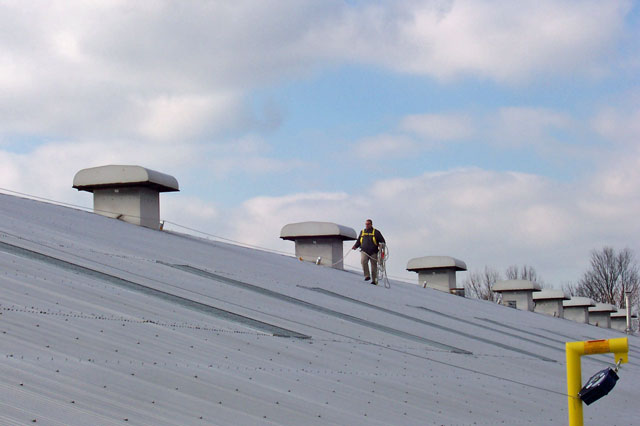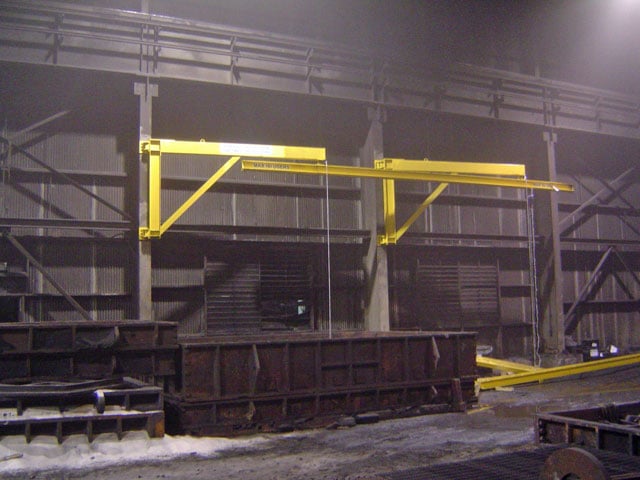Fall Protection & Fall Arrest Systems for Steel Erection
Steel erection is one of the most hazardous jobs in the construction industry with falls being routinely cited as the leading cause of injuries and fatalities. Although OSHA makes special exceptions to fall protection standards for steel erection, this market segment is still highly regulated. Worker safety can only be ensured by partnering with a fall protection company that understands the slip and fall hazards associated with steel erection. Providing safe access for steel erectors requires a comprehensive fall prevention strategy, which includes the proper mix of fall protection equipment, a descent and rescue plan, personnel training, and partnering with a fall protection company that appreciates the unique nature of your construction site’s access points and potential fall hazards.

Stell Mill Fall Protection

Stell Mill Fall Protection

Stell Mill Fall Protection
We are a complete turnkey provider of fall protection systems designed for the steel erection industry and have the years of design and installation experience in this market sector. Contact us for expert assistance with your fall arrest, fall restraint and fall protection safety requirements.
Fall Protection Solutions
-
Guardrail
View Guardrail -
Horizontal Lifelines
View Horizontal Lifelines -
Fall Protection Anchors
View Fall Protection Anchors
Design Considerations
Construction Fall Protection Design Considerations
Effective construction industry fall protection begins with education. Contrary to the views of many, cost effective fall protection system designs that do not lower worker productivity exist, and thanks to application specific PPE, construction workers can safely and efficiently perform their tasks with 100% tie-off. Effective system design will allow workers to use both hands at all times, which is important because of the weight of the beams and the complexity of the work performed. On upper surfaces lacking overhead structure, beam gliders may be utilized to keep workers tied off at all times. Although the steel erection industry is a challenging field, effective fall protection solutions do exist; raising the level of awareness is an important step toward creating a safer work environment.
AT DFP, we appreciate the unique nature of the steel erection industry’s access points, fall hazards, and the need for fall arrest solutions that are tailored to your specific application. Furthermore, it is extremely helpful to understand the types of materials and conditions associated with the site in en effort to provide you a recommendation that is specifically tailored to your needs.
Our years of experience designing and installing fall protection systems for the steel erection industry and our proven track record of training personnel in the safe use of these systems will keep your employees safe and your construction site in compliance with all OSHA fall protection regulations. To learn more about fall arrest systems for the steel industry, or to discuss your application, contact the fall protection specialists at DFP for more information.
OSHA Regulations
- Guardrail
- 1926.502(b)
'Guardrail systems.' Guardrail systems and their use shall comply with the following provisions: - 1926.502(b)(1)
Top edge height of top rails, or equivalent guardrail system members, shall be 42 inches (1.1 m) plus or minus 3 inches (8 cm) above the walking/working level. When conditions warrant, the height of the top edge may exceed the 45-inch height, provided the guardrail system meets all other criteria of this paragraph. - 1926.502(b)(2)(iv)
Other structural members (such as additional midrails and architectural panels) shall be installed such that there are no openings in the guardrail system that are more than 19 inches (.5 m) wide. - 1926.502(b)(3)
Guardrail systems shall be capable of withstanding, without failure, a force of at least 200 pounds (890 N) applied within 2 inches (5.1 cm) of the top edge, in any outward or downward direction, at any point along the top edge. - 1926.502(b)(4)
When the 200 pound (890 N) test load specified in paragraph (b)(3) of this section is applied in a downward direction, the top edge of the guardrail shall not deflect to a height less than 39 inches (1.0 m) above the walking/working level. Guardrail system components selected and constructed in accordance with the Appendix B to subpart M of this part will be deemed to meet this requirement. - 1926.502(b)(5)
Midrails, screens, mesh, intermediate vertical members, solid panels, and equivalent structural members shall be capable of withstanding, without failure, a force of at least 150 pounds (666 N) applied in any downward or outward direction at any point along the midrail or other member. - 1926.502(b)(11)
When guardrail systems are used at holes, they shall be erected on all unprotected sides or edges of the hole. - 1926.502(b)(12)
When guardrail systems are used around holes used for the passage of materials, the hole shall have not more than two sides provided with removable guardrail sections to allow the passage of materials. When the hole is not in use, it shall be closed over with a cover, or a guardrail system shall be provided along all unprotected sides or edges. - 1926.502(b)(13)
When guardrail systems are used around holes which are used as points of access (such as ladderways), they shall be provided with a gate, or be so offset that a person cannot walk directly into the hole.
- 1926.502(b)
Talk to a fall protection specialist
Tell us about your fall protection needs, and we’ll configure a system that rises to your challenges.

